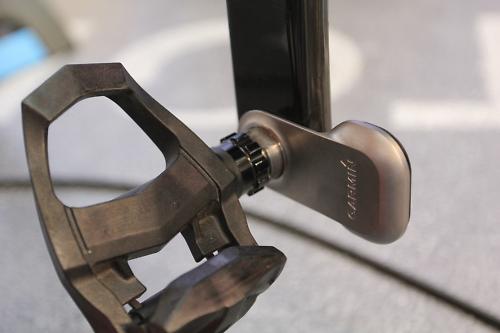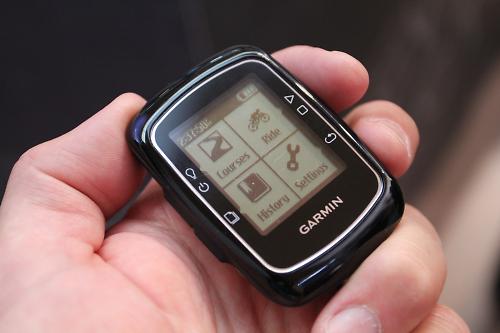- News
- Reviews
- Bikes
- Accessories
- Accessories - misc
- Computer mounts
- Bags
- Bar ends
- Bike bags & cases
- Bottle cages
- Bottles
- Cameras
- Car racks
- Child seats
- Computers
- Glasses
- GPS units
- Helmets
- Lights - front
- Lights - rear
- Lights - sets
- Locks
- Mirrors
- Mudguards
- Racks
- Pumps & CO2 inflators
- Puncture kits
- Reflectives
- Smart watches
- Stands and racks
- Trailers
- Clothing
- Components
- Bar tape & grips
- Bottom brackets
- Brake & gear cables
- Brake & STI levers
- Brake pads & spares
- Brakes
- Cassettes & freewheels
- Chains
- Chainsets & chainrings
- Derailleurs - front
- Derailleurs - rear
- Forks
- Gear levers & shifters
- Groupsets
- Handlebars & extensions
- Headsets
- Hubs
- Inner tubes
- Pedals
- Quick releases & skewers
- Saddles
- Seatposts
- Stems
- Wheels
- Tyres
- Health, fitness and nutrition
- Tools and workshop
- Miscellaneous
- Tubeless valves
- Buyers Guides
- Features
- Forum
- Recommends
- Podcast
news
Garmin launch Vector power pedal and Edge 200 computer
Garmin's booth was awash with punters at Eurobike, most of them drawn by the lure of the Vector power measuring pedal. Garmin haven't been much involved with the actual power measurement side before, even though their ANT+ devices allow other systems to be hooked up, but their acquisition of Metrigear last year signalled their intentions and the Vector is the fruit of that collaboration.
Seen power measuring pedals before? Of course you have, at last year's Eurobike. Polar had theirs on display, a collaboration with Look, and O-Synce had a prototype working on their stand too. Garmin's Vector joins a gathering throng, and power measuring pedals have significant advantages over measurement at other points in the transmission. Chief amongst them is that the pedals are easily transferred to another bike, meaning that you can switch your power pedals to your TT bike or winter trainer (or even your 'cross bike or MTB, if you're brave and don't mind climbing muddy banks in your road shoes) and continue to log your progress with minimum fuss.

The system is easy to fit too; it's a home job rather than something that needs to be done in a bike shop, and the pedals are supplied ready calibrated. Power is calculated by comparing the deflection in the pedal spindle to a known deflection under load, and calculating a force from that. In conjunction with the cadence, measured with accelerometers in each pedal, you get a power reading which is beamed to your Garmin of choice (Edge 800, 500, 705 and Forerunner 301XT) via the ANT+ protocol. You get an overall power reading, plus a percentage split from each leg so you can see where your power is coming from. If you have an Edge 800 or 500 it can also display TrainingPeaks™ metrics for Normalized Power (NP™), Intensity Factor (IF™) and Training Stress Score (TSS™). We don't really know what those are, but it sounds impressive.

The transmitter plugs into the pedal spindle and sits behind the crank in a similar position to the Polar system. O-Synce's transmitter is built into the pedal base. The Vector pedal is Look Kéo compatible, just like Polar's, so if that's your platform of choice you can take your pick. Neither is going to be particularly kind on your wallet, though. To get your mitts on a pair of Vector pedals you're going to have to hand over £1,149, which is in the same ball park as other power measuring devices.

Also on the stand, but on a kind of need-to-know basis (ie it wasn't actually on display) was the new Garmin Edge 200. It's the baby brother of the Edge 500 and exactly the same size, but it doesn't have any ANT+ capability. That means you can leave your HRM and Vector pedals at home and just go out for a nice ride, and when you get back you can share your ride with your mates on Garmin's excellent Connect website.
While it's on the bike the 200 will also function as a fully featured (and customisable) bike computer, and you can upload routes to the unit and follow them as a dotted line, like you can on the 500; obviously the 200 doesn't support proper mapping. On top of the standard computer functionality there's also a range of GPS/memory related functions such as virtual partners where you can also race yourself over a set course, and the 200 will display how far ahead or behind you are.

And the price for all this? Just £129, which isn't much more than you'd pay for a top-end non-GPS computer. Sounds like a good deal to us, and we reckon it'll appeal to a wide range of riders, from commuters logging their miles to more serious cyclists who want to keep a detailed log of their training but aren't into HRM or power data. It also has the advantage that all GPS computers have: there's no sensor to fit and it's a simple job to switch it between bikes. The Edge 200 can store 130 hours of ride data, and it'll run for a claimed 14 hours before recharging. Given our experiences with the Edge 500 and 800, we'd be inclined to believe those claims, just about. You'll be able to get one soon.
Dave is a founding father of road.cc, having previously worked on Cycling Plus and What Mountain Bike magazines back in the day. He also writes about e-bikes for our sister publication ebiketips. He's won three mountain bike bog snorkelling World Championships, and races at the back of the third cats.
Latest Comments
- EM69 12 min 48 sec ago
Absolutely, I have been very lucky on countless occasions due to activity like this by ignorant motorists some of whom know I'm there. Really pees...
- Wingguy 13 min 21 sec ago
Well... the 'A' in CdA stands for area, so of course you can make a tiny, tiny bike and claim that it is more aerodynamic. That doesn't mean it is...
- Clem Fandango 29 min 38 sec ago
The culture warriors would insist you can achieve similar results in Croydon - French elan nothing - what abaht British values! ...
- chrisonabike 47 min 58 sec ago
Hmm... not up-to-date with the funding / business model of Lime but most previous dockless bike systems I've been aware of were seem to be at best...
- chrisonabike 1 hour 11 min ago
Reminds me of Cold War Steve's video for Sleaford Mods...
- Hirsute 1 hour 18 min ago
I have a couple of head torches, but they look like this Nicely angled down so you can see where you are treading.
- bobbinogs 1 hour 20 min ago
Yepp, another vote for Argos, fantastic quality and realistic with their leadtimes. The only downside is the number of lovely bikes they have at...
- The_Ewan 1 hour 44 min ago
I think that part of the reason for the limited mount is that the shaped 'road' beam means that it can't be mounted upside down, otherwise you'd...
- momove 1 hour 49 min ago
Thanks for posting. Have signed as well and pleased to see it's over 100,000 so it will at least be raised....
- Jem PT 2 hours 11 min ago
Tom Dumoulin's half marathan time may be quick, but surely Chris Froome would be quicker??






Add new comment
6 comments
My Exustar pedals just fell apart and they're less than 6 mths old!
Why the look type pedal ???? - this is shaky ground for garmin on this pedal selection - what happens if your Time or Speedplay ? lol = garmin: go back to the drawing board!
The Look/Polar collaboration will lock you into Look pedals as well but what about the 3T/Saris deal where the Watts measurement takes place at the rear wheel therefore allowing any pedals you want? Story here: http://road.cc/content/news/41601-3t-saris-powertap-collaboration-will-a... Only downside I can see with Saris is that the watts measurement is total whereas the pedal-based systems show each leg individually. Shame because MetriGear's collaboration before it was bought by Garmin was with Speedplay. Presumably Garmin didn't feel Speedplay would please a wide-enough selection of riders?
UPDATE: Speedplay are now collaborating with the Brim Brothers 'Zone' system, measuring the power at the cleat and transmitting from a little pod clasped to the top of each foot.
I saw these in Melbourne, on display, and again here, on display...has anyone actually pedalled on them; or is that not allowed?
I thought when it was first announced they were talking "affordable"? Sure, it's more affordable than SRM cranks, and probably lighter than a powertap hub, but it doesn't fall into the affordable category per my definition...
Very disappointing that Garmin chose to use pedal bodies without reenforcing wear plates. Not sure I'd want to spend twelve hundred squids on something that'll be worn out in 2 seasons. I had a pair of Look Keo carbons that the contact area wore down on after a couple of years. No such wear from Keo max or Shimano. I'd rather replace the cleats than the pedal bodies.